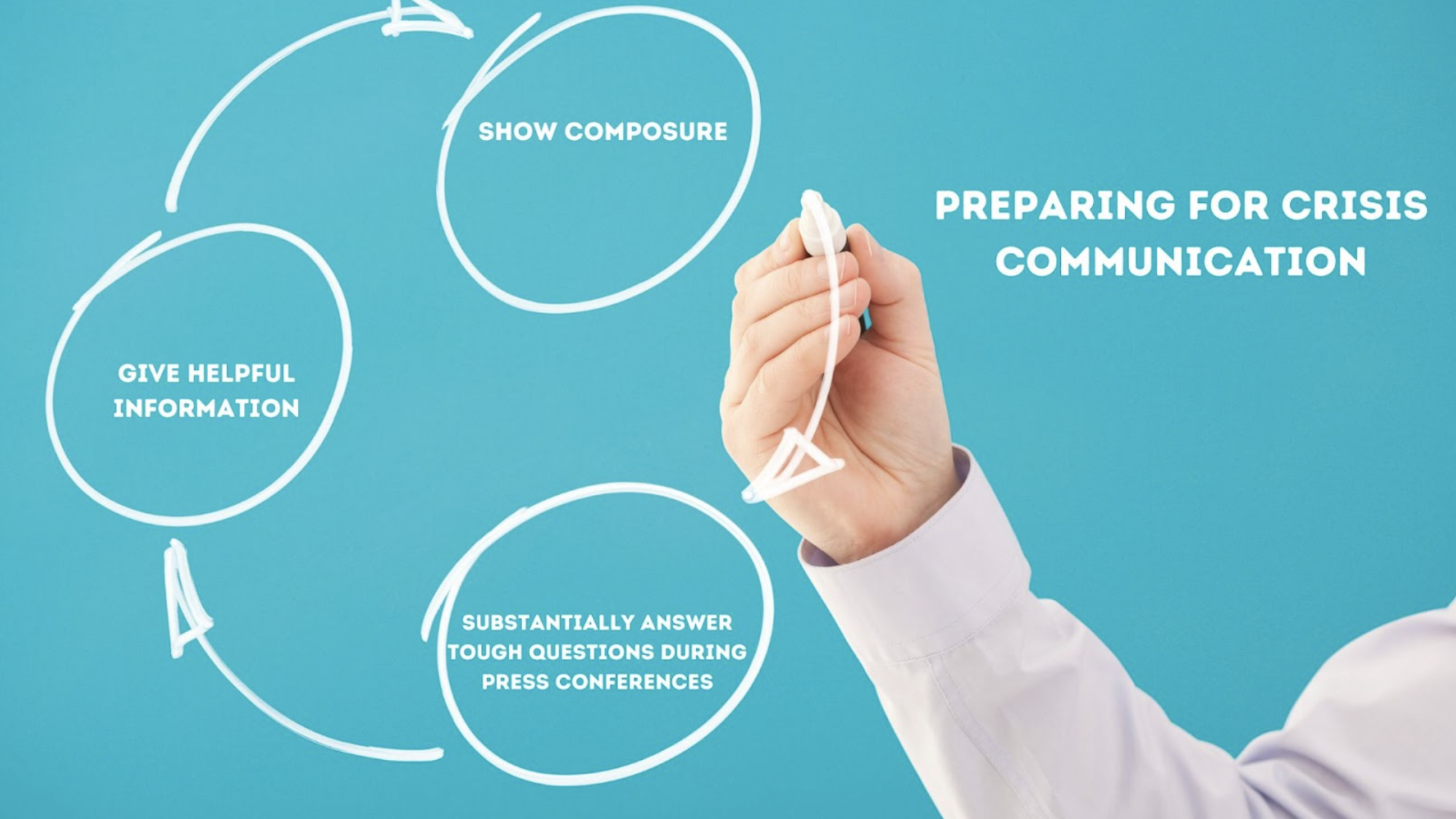Effective communication is crucial for any leader, and it’s especially vital for a CEO guiding their company through challenging times. In times of adversity, stakeholders look to the company’s leadership for guidance, reassurance, and transparency. The way a CEO communicates during turbulent times can significantly impact the business, its employees, customers, and the public’s perception of the brand.
The Role of CEOs During Challenging Times
As the head of an organization, the CEO establishes the tone for crisis response by providing clarity, vision, and direction during uncertainty. Their communication and messaging aims to:
- Build Trust: Foster trust and credibility through frequent, transparent communication. Admit uncertainties and commit to updates.
- Rally Employees: Motivate with compassion and empathy. Provide context on decisions and share unifying stories to encourage resilience.
- Shape Perceptions: Influence external views through responsible, decisive messaging that conveys control and instills confidence in leadership and brand.
Why Crisis Communication Matters for CEOs
Crisis communication is the strategic management of communication during an event that could potentially harm a company’s bottom line or stakeholders. It involves proactive planning and preparation, timely and accurate information sharing, clear and consistent messaging, and a coordinated response. There are tangible reasons why an investment in crisis communication skills pays dividends for CEOs and organizations:
Mitigates Reputational Damage
- Companies rely heavily on maintaining a positive brand image and reputation. In a crisis, their reputation can quickly become tarnished if they are perceived as mishandling the situation or not being transparent.
- Poor, misleading, or absent communication breeds distrust among stakeholders like customers, employees, shareholders, etc. It makes the company seem uncaring, incompetent, or dishonest.
- Good communication helps mitigate or lessen this reputational damage by showing the company cares and is being as transparent as reasonably possible. This preserves stakeholder trust and loyalty.
Reduces Uncertainty
- In a crisis, there is usually a high degree of uncertainty about what is happening, how bad it is, and what will happen next. This creates anxiety.
- Clear, frequent communication from leaders about the realities of the situation and how the company plans to move forward provides valuable information to employees and external stakeholders.
- This helps reduce speculation, rumors, and overall confusion – bringing a sense of certainty in a turbulent time.
Drives Adaptive Change
- Navigating a crisis requires evolving strategies and plans as circumstances change. Companies often have to pivot.
- Explaining the rationale behind difficult decisions related to these pivots helps stakeholders understand why they are necessary based on new developments.
- This facilitates stakeholder buy-in and alignment behind the adaptive change.
Accelerates Recovery
- When employees rally behind senior leadership and feel bonded by a shared purpose, they execute recovery plans more efficiently.
- Strong communication fosters teams working collaboratively to overcome challenges. It motivates them and leads to better outcomes faster.
- The company recovers quicker when everyone has clarity of purpose.
Preparing for Crisis Communication

Every CEO must cultivate crisis readiness long before turbulence hits. Good crisis communication planning is robust. It finds risks using methods like failure modes and effects analysis. Established monitoring procedures triggered by early warning sign detection enable rapid response. Comprehensive plans outline various specific crisis scenarios and protocols.
Good plans have spokespeople. They also have template statements. They define the main communication channels. These are based on stakeholder preferences. They also outline how update frequency may change by type of message. This can vary by the type of message and as the situation changes. It applies to employee emails, customer notifications, press releases, and social media. Proper media training prepares designated spokespeople to:
- Show composure
- Give helpful information
- Substantially answer tough questions during press conferences.
How CEOs Can Communicate Effectively During Challenges
Today’s CEOs must strategically leverage both traditional and digital media and enterprise communication tools during crises. Equipping CEOs with crisis communication best practices prepares them to lead dynamically through turmoil. There are key areas CEOs must address:
Be Visible
Leaders should increase touchpoints via company meetings, video messages, and informal check-ins. Visibility signals commitment, care, and focus during destinations. Employees and stakeholders feel heard, understood, and valued.
Provide Context
Share relevant data, projections, and stories to contextualize the challenges at hand. Arm stakeholders with insights to illuminate the rationale behind difficult decisions. Context aligns people with the “why” behind the change.
Acknowledge Emotions
Name and validate emotions like frustration, anger, confusion, anxiety, or sadness. Emotional connections forge trust and convey messages that resonate at a profound level.
Cast Vision
Paint a picture of the future destination. Share hope grounded in reality by outlining a step-by-step path forward. A vision unifies teams and provides direction amid complexity.
Over Communicate
Err on the side of overcommunicating during a crisis. Repeat key messages across multiple channels understanding messaging may get lost in the noise of drastic change. Consistent reinforcement ensures directives stick.
Listen Intently
Create bidirectional communication channels. Seek direct feedback through surveys, small groups, and employee liaisons. Listen intently to understand lived experiences and evolving needs.
Model Resilience
Share stories highlighting moments of leadership resilience, vulnerability, and growth. Represent the grit and tenacity teams aim to embody. Changing context calls for leaders to model how to evolve.
Provide Reassurance
Change brings uncertainty, which can lead to fear and doubt. As a leader, provide reassurance by emphasizing the organization’s strengths, resources, and ability to weather storms. Remind teams of shared values and past successes as a compass for navigating future obstacles. Conveying confidence in people and plans calms nerves.
Cultivate Gratitude
Gratitude shifts mindsets from scarcity to abundance. During turbulent times, actively appreciate ongoing dedication, flexibility, and effort. Recognize the unseen work keeping operations afloat. Express sincere thanks on behalf of the organization for people’s perseverance. Gratitude sustains loyalty.
By dedicating themselves to honing crisis leadership skills CEOs can shepherd their organizations skillfully through adversity. Their communication choices profoundly influence outcomes. The scope of people impacted by executives empowered to communicate effectively in times of crisis is far-reaching. The potential for exponential impact makes crisis communication mastery vital for 21st-century leaders.
Effective Strategies for Crisis Communication
Today’s CEOs must leverage both traditional and digital media to communicate during crises. Press releases and interviews on mainstream outlets convey timely statements and build rapport. Social networks address rumors, provide updates, and counter misperceptions. The CEO’s direct messages offer custom support to key stakeholders.
A robust readiness for crises necessitates planning, monitoring procedures, and media training. Comprehensive plans outline scenarios, protocols, spokespeople, and preferred communication channels. The frequency of updates should adapt to situation changes. Clear, consistent messaging prevents misinformation. Admitting uncertainties shows transparency and proactive investigation. Framing should adjust based on audience needs – employees, customers, and shareholders.
Proactive press releases frame narratives. Interviews display empathy, solutions-focus, and strategic composure. Social media allows CEOS to guide conversations by responding to concerns transparently. Post-crisis evaluation analyzes communication efficacy – frequency, timeliness, and sentiment trends. Assessments identify improvements to readiness like media training, response coordination, and enhanced listening. Updated plans enhance preparedness for the future.
Real-World Examples of Effective Crisis Leadership Communication
Delta Airlines CEO Demonstrates Compassion and Transparency During Pandemic
Ed Bastian used frequent video messaging to reassure passengers about policies, schedules, and safety procedures during a challenging travel environment. His tone conveyed genuine care and understanding while outlining transparent cleaning protocols to alleviate passenger concerns.
BP Rebuilds Trust After Oil Spill Crisis Through CEO Empathy
Replacement CEO Bob Dudley helped revive reputation by acknowledging regional impacts and demonstrating an understanding of affected communities. By expressing accountability in commercials, he set a reconciliatory tone while launching wildlife funds and settlements to make amends.
Boeing Bounces Back After Controversy By Apologizing And Committing To Transparency
New CEO David Calhoun regained credibility by pledging collaboration with regulators and communicating resolve to rectify aircraft issues. His clear directives helped shareholders rally around transparency goals to safely return the 737 MAX to service through design modifications and pilot retraining.
Conclusion
Crisis communication is an underappreciated CEO skill. It inspires confidence and earns stakeholder trust. No executive desires hardship for their company. Navigating turbulence well shows good leadership.
CEOs can help by understanding crisis types. They can also prepare coordinated responses. And they can communicate clearly and empathetically across many channels.
Challenges will arise. But, if we stay true to our values and mission and support those impacted, we will dispel doubt and fear. CEOs have the power to turn trials into opportunities, doing so with courage, compassion, and commitment, thus uniting people behind a common purpose.
FAQs
What are some best practices for crisis response messages?
Craft messages that are clear, concise, accurate, consistent, and transparent. Use plain language to eliminate confusion and address key stakeholder concerns based on the situation. Admit uncertainties you are investigating and pledge regular updates. Accuracy and honesty build trust.
How much information should CEOs disclose?
Balance transparency with caution when disclosing details. Stick to confirmed facts from investigations. Acknowledge realities and admit what remains uncertain or undisclosed for now. Provide context without conflation. Update frequently as new verified details emerge.
What are some CEO media interview best practices?
Focus on bringing the conversation towards resolution over blame. Express empathy and discuss incident specifics only once verified internally. Redirect reporters trying to exacerbate tensions. Share corrective actions underway and reaffirm commitment to those impacted. Prepare 2-3 messages aligned around transparency and accountability.
